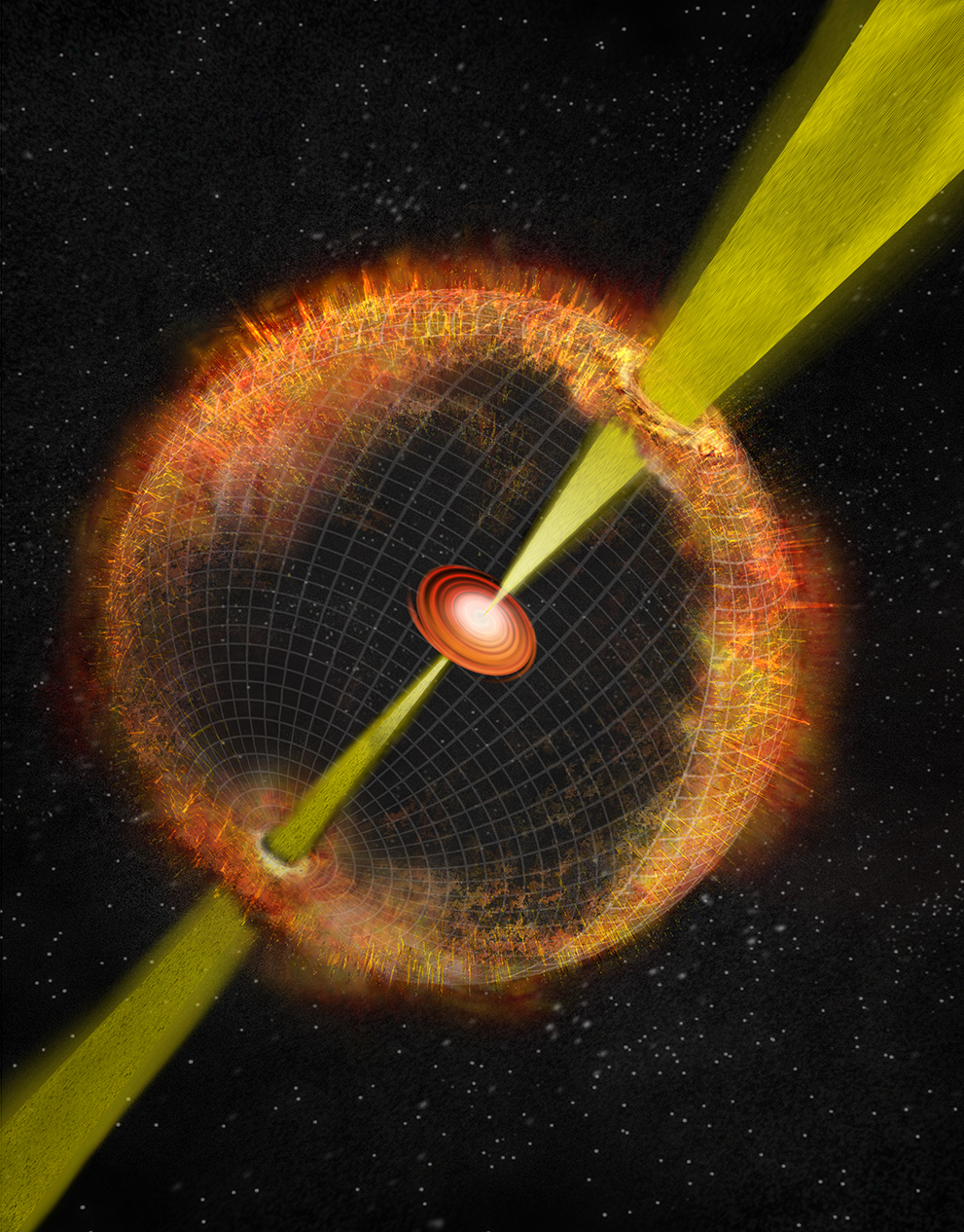
Space Cow Mystifies Astronomers
Could we be witnessing a dying star giving birth to an X-ray engine?
- What the birth of a black hole or neutron star looks like
- That astronomy isn’t always as simple as looking up with a telescope and noting down what you see
- How astronomical observations can be compared to an Indian parable
Q. What is a transient, and why it is interesting to study them?
A. The night sky appears calm but it is actually incredibly dynamic, with stars exploding in distant galaxies, visible through our telescopes as flashes of light. The word “transient” refers to a short-lived phenomenon in the night sky, which could be the explosion of a dying star, a tidal disruption event, or a flare from a star in the Milky Way. And there are probably many other types of transients out there that we have not even discovered!
Q. So given that transients are sudden phenomena that you can’t predict, how can you possibly plan for studying them?
A. It’s kind of a case of reacting to their appearance. In the past few years, we’ve entered this amazing new era of astronomy where telescopes can map out the entire sky every night. By comparing tonight’s map to last night’s map, we can see exactly what has changed over the previous 24 hours. The transients I study are very short-lived explosions — lasting between a few hours and a few months — so when an interesting one happens, we have to drop everything and react. Luckily I love my research enough to do this!

Q. In June 2018, you observed an unusual transient that was named AT2018cow, or The Cow. Can you describe this phenomenon? What made it so remarkable?
A. One night, astronomers saw a point of light in the sky that had not been there before: a new transient! The Cow was particularly special for two reasons: firstly, it was VERY bright, and secondly, it had achieved that brightness VERY quickly. This was exciting, because usually if a transient appears very quickly, it is not so bright, and a very bright transient takes a long time to become bright. So we realised immediately that this was something strange.
Q. You chose to study this transient with two millimetre telescopes: the Submillimeter Array (SMA) and ALMA (Atacama Large Millimeter/Submillimeter Array). What do millimetre telescopes offer over other telescopes?
A. In the early stages of a transient (in its first few weeks of existence), we can see the shockwave emitted by an explosion by capturing light at millimetre wavelengths — this is exactly what SMA and ALMA can see. In particular, thanks to ALMA we were able to learn that in the case of The Cow, the shockwave was travelling at one-tenth of the speed of light, that it is very energetic, and that it is travelling into a very dense environment.
We also used the Australia Telescope Compact Array to look at light from the transient with longer wavelengths. It is only by using lots of different telescopes that we can really get a full picture of a transient.
By combining ALMA data with publicly available X-ray data, we were also able to conclude that there must be some ongoing energy production — a kind of continuously-running “engine” at the heart of the explosion. This could be an accreting black hole or a rapidly-spinning neutron star with a strong magnetic field (a magnetar). If The Cow does turn out to have either of these at its centre, it would be very exciting, since it would be the first time that astronomers have witnessed the birth of a central engine.
Q. It seems that nobody’s quite sure what The Cow is. Why is there so much uncertainty still surrounding this object?
A. It’s because the combination of The Cow’s properties is so unusual. It’s like that parable of the blind man and the elephant — where several blind men each feel a different part of an elephant and come to different conclusions about what it might look like. If you look at the visible light from The Cow, you might conclude that it is a tidal disruption event. On the other hand, if you look at the longer-wavelength light you see the properties of the shockwave and the density of the surrounding matter, and might conclude that it’s a stellar explosion. It’s incredibly difficult to reconcile all of the properties into one big picture.

Q. How will you find out what The Cow really is?
A. Right now, the heart of the explosion is shrouded in gas and dust so it’s difficult to see it. Over the next months, this gas and dust will expand out into space, becoming thinner and more transparent, and allowing us to peer inside. When we are able to see into that central engine, we will be able to learn more about what it there, whether it’s a black hole, a neutron star, or something else entirely.
Q. What do you think The Cow is, and why?
A. Personally, I think it’s most likely to be a stellar explosion. Our ALMA observations enabled us to measure the surrounding environment to be incredibly dense — 300 000 particles per cubic centimetre! This kind of density is typical of a stellar explosion. Some people suggest it’s a tidal disruption event, but I think this would be difficult to explain. That said, I’m far from an expert on tidal disruption, so I look forward to hearing more from theorists on how to reconcile that model with our observations.
Q. So what are the implications of this discovery? What does The Cow teach us about transients?
A. From my perspective, The Cow is incredibly exciting for two reasons. One is astrophysical — what it can teach us about the death of stars. We think we’ve witnessed the birth of a central engine, an accreting black hole or a spinning neutron star, for the first time.
The second reason is technological — we learned that this is a member of a whole class of explosions that in their youth emitted bright light at millimetre wavelengths. In the past, millimetre observatories like ALMA were rarely used to study cosmic explosions, but this study has opened the curtain on a new class of transients that are prime targets for millimetre observatories. Over the next few years, we hope to discover many more members of this class, and now we know that we should use millimetre telescopes to study them!
Numbers in this article
| 66 | Number of antennas that make up ALMA |
| 2018 | Year that The Cow first appeared |
| 5000 | Altitude of ALMA in metres |
| 300 000 | Number of particles per cubic centimetre in the environment surrounding The Cow |
Biography Anna Ho
Anna Ho is an Astronomy graduate student at California Institute of Technology (Caltech) and a National Science Foundation Graduate Research Fellow. For her research, she uses a network of telescopes across the world and in space to investigate the catastrophic deaths of stars. More specifically, she is interested in a rare, extreme class of stellar death: explosions powered by a central engine, like an accreting black hole or a spinning neutron star. Prior to starting at Caltech, she obtained an undergraduate degree in Physics from Massachusetts Institute of Technology and spent a year on a Fulbright Scholarship in Heidelberg, Germany.


